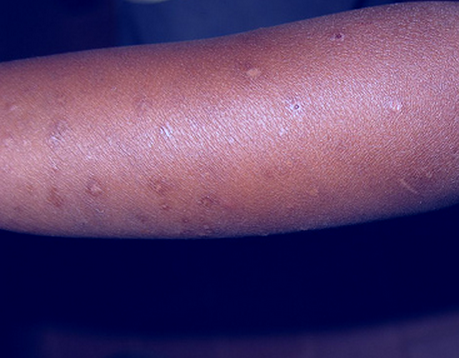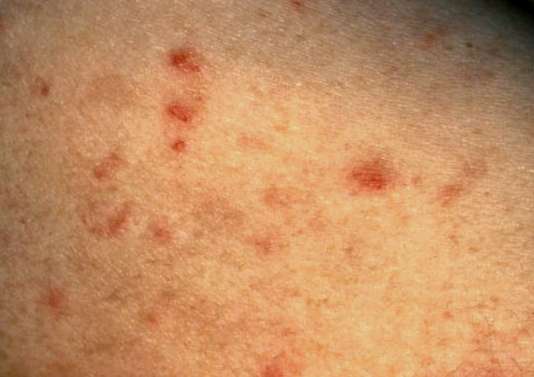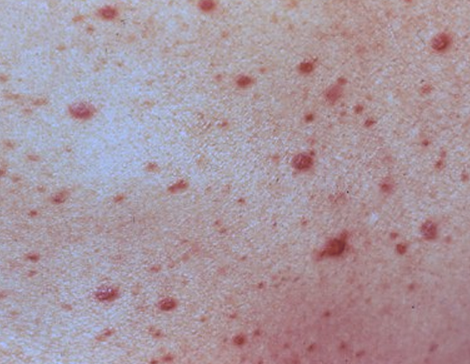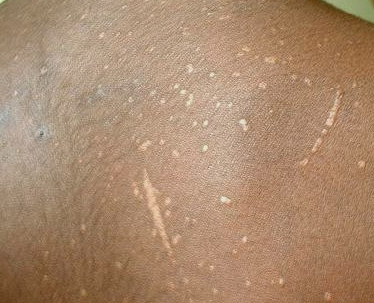Infection with the human immunodeficiency virus or HIV can lead to the formation of pigmented and dark rashes throughout the body. Such abnormal rashes are referred to as HIV rash. These rashes usually make an appearance 2 to 3 weeks after the initial infection.
The primary cause of HIV rash is infection with the HIV virus. It can also be caused as a side-effect of the medications used to manage the symptoms of HIV infection. HIV rashes are usually not contagious. They typically last for about 2 to 3 weeks.
Symptoms of HIV rash
Some of the signs and symptoms of HIV rash are listed below:
- HIV rash may develop in the form of eczema-like lumps, or they may look like groups of brown or reddish pimples.
- The rashes may also occur as lesions, blisters, or abnormal sores or patches which affect various mucous membranes in the body like the mouth, genitals, and eyes.
- HIV infection can sometimes result in peeling of the skin, which can then give rise to the lesions.
- Itchiness of the HIV rashes is quite rare.
- There are several other symptoms which may accompany HIV rashes such as fatigue, unexpected fever, diarrhea, cramps and muscle aches, increased stiffness and pain in the joints, inflamed glands, memory loss, vision problems, and weight loss due to a decreased appetite.
HIV rash can appear in the following locations:
- HIV rashes can affect the trunk or the torso. They may appear as pigmentations or discolorations. Such abnormal skin patches may be more noticeable in the chest region as opposed to the back.
- In some instances, HIV rash may occur on the arms, feet, or the hands. In rare cases, HIV rash may appear as bumps on the feet or the hands.
- The face as well as the neck may also experience HIV rashes
- As an HIV infection progress towards the final stages, the HIV rashes may occur across the body, especially causing the formation of lesions, sores, and blisters in the genital and oral regions.
Types of HIV rash
- Herpes rashes: These rashes are inflamed and full of fluids. They are reddish in color. Then tend to rupture after growing completely. Herpes rashes occur in the mouth and the genitals
- Drug rash: The intake of HIV medicines can lead to the formation of drug rashes. They occur as hives or tiny bumps and are often accompanied by peeling of the skin.
- Acute infection rashes: These rashes are not as harmful as the others, and typically fade away within 3 weeks. They make an appearance 3 to 4 weeks after the initial HIV infection and affect the limbs, torso, and palms.
- Symptomatic form of HIV rashes: These rashes occur during the final stages of AIDS, when the patient experiences debilitating and persistent abnormalities. The symptomatic type of HIV rashes may be scaly, dry, and pinkish. They affect the armpits, face, chest, and scalp.
There are several other kinds of HIV rashes which may be caused due to additional infection by other viruses, bacteria, or fungi. Such rashes typically develop due to the compromised immunity of the patient, and can be contagious.
A few examples of bacterial HIV rashes are:
- Eosinophilic follictus consists of rashes that affect the upper area of the body and form around the hair follicles. They are itchy and reddish.
- Hives may develop on the skin due to drug or food allergies
- Scabies result in abnormal rashes which are extremely itchy at night. They occur on the waist, feet, elbows, and palms.
- Bacterial follictus which develops in the hair follicles and causes yellowish rashes
- Psoriasis is identified by scaly, reddish patches on the skin
A few examples of viral HIV rashes are:
- HPV warts which result in the formation of swollen, small, and reddish bumps. They occur throughout the body.
- Mollucsum contagiosum affects the moist sections of the body. The infection transfers via bed sheets, clothes, towels, and other personal items that are shared.
Examples of fungal HIV rashes are:
- Tinea refers to a temporary, mild, and contagious rash which results in discomfort. It may cause athlete’s foot, jock itch, or other abnormalities like ringworm infection.
HIV rashes: Treatment, relief, and prevention
It is important to diagnose the cause of all types of rashes before commencing the treatment. HIV rashes generally last for one to two weeks. If a person experiences abnormal skin rashes along with the above discussed symptoms, then it is essential to seek immediate medical attention.
Currently, there is no known cure for HIV infection. Most doctors recommend the use of non-prescription medications to alleviate the associated itchiness, irritation, and discomfort. Doctors may also advise patients of HIV rashes to avoid contact with extreme heat or cold, as it can aggravate the skin itchiness as well as the HIV rashes.
It is also important for people to be aware of the varied ways in which they can contract an HIV infection, and then follow all the guidelines to prevent the condition. A few key ways to stop HIV infections include avoiding all forms of blood-to-blood contact and practicing safe sex.
In case the HIV rashes are caused due to the intake of drugs, then a patient should consult the doctor and go for alternative medicines. It is also important for affected individuals to avoid the intake of such drugs after the HIV rashes have disappeared, unless recommended by a physician.
Patients may follow the below listed self-care guidelines to find relief and prevent the onset of HIV rashes:
- Avoid exposure to direct sunlight or extreme heat
- Patients should also stay away from extremely cold weather conditions or climates
- People from the high risk groups should avoid having unprotected sex so as to prevent the onset of contagious HIV rashes. It is also important to avoid all forms of direct blood contact
- OTC medications such as hydrocortisone cream and Benadryl can be used to alleviate itchiness
- Do not use fabrics that may worsen itchiness. Also, avoid wearing tight apparels
- Use cool ointments and take cool showers on a daily basis. Stay away from hot baths or showers
- Avoid the consumption of foods which can trigger an onset of HIV rashes
HIV Rash – Pictures
These HIV rash images indicate formation of little lump like formation on the skin, which is usually non-itchy






We are building a large collection of sex-related texts, easy to navigate, categorized, without advertising. Anyone can have us publish their texts, for free.